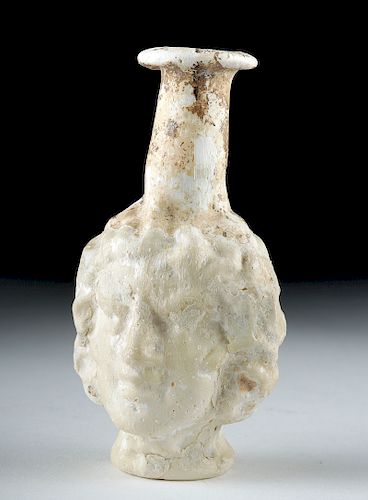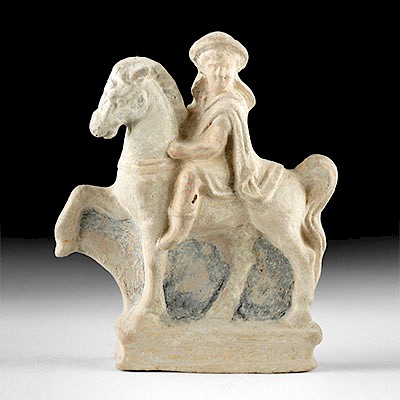Roman Opaque White Glass Janiform Unguentarium
Lot 48d
About Seller
Artemis Gallery
686 S Taylor Ave, Ste 106
Louisville, CO 80027
United States
Selling antiquities, ancient and ethnographic art online since 1993, Artemis Gallery specializes in Classical Antiquities (Egyptian, Greek, Roman, Near Eastern), Asian, Pre-Columbian, African / Tribal / Oceanographic art. Our extensive inventory includes pottery, stone, metal, wood, glass and textil...Read more
Estimate:
$1,500 - $2,000
Absentee vs Live bid
Two ways to bid:
- Leave a max absentee bid and the platform will bid on your behalf up to your maximum bid during the live auction.
- Bid live during the auction and your bids will be submitted real-time to the auctioneer.
Bid Increments
| Price | Bid Increment |
|---|---|
| $0 | $25 |
| $300 | $50 |
| $1,000 | $100 |
| $2,000 | $250 |
| $5,000 | $500 |
| $10,000 | $1,000 |
| $20,000 | $2,500 |
| $50,000 | $5,000 |
| $100,000 | $10,000 |
| $200,000 | $20,000 |
About Auction
By Artemis Gallery
May 9, 2019
Set Reminder
2019-05-09 10:00:00
2019-05-09 10:00:00
America/New_York
Bidsquare
Bidsquare : Ancient | Asian | Ethnographic
https://www.bidsquare.com/auctions/artemis-gallery/ancient-asian-ethnographic-4110
Featuring classical antiquities, ancient and ethnographic art from cultures encompassing the globe. All legally acquired, legal to sell. Satisfaction guaranteed. Convenient in-house shipping. Artemis Gallery info@artemisgallery.com
Featuring classical antiquities, ancient and ethnographic art from cultures encompassing the globe. All legally acquired, legal to sell. Satisfaction guaranteed. Convenient in-house shipping. Artemis Gallery info@artemisgallery.com
- Lot Description
Roman, Sidonian, Imperial Period, ca. 2nd to 4th century CE. A fine Janus-headed vessel of a petite size, mold-formed from opaque white glass. The vessel depicts two heads of a man - perhaps Bacchus with tufts of wavy hair - and rests upon an integral concave base with a cylindrical neck and in-folded rim on top. Vessels of this type seem to have been an invention of the 2nd century CE which continued into the 3rd and 4th centuries. A lovely unguentarium or perfume bottle of a rare double or janiform presentation covered in brilliant white iridescence. Size: 1.8" W x 3.25" H (4.6 cm x 8.3 cm).
Sidon was a center of art glass production in ancient times. Here are Pliny's words as he described his voyage to Sidon, "From this point on we must go back to the coast and to Phoenicia. There was formerly a town called Crocodilian, and there still is a river of that name...Then comes Cape Carmel...Next are Getta, Geba, and the river Pacida or Belus...Close to this river is Ptolemais...Next Tyre, once an island separated from the mainland by a very deep sea-channel 700 yards wide, but now joined to it by the works constructed by Alexander when besieging the place...but the entire renown of Tyre now consists in a shell-fish and a purple dye!...Next are Zarephath and the city of birds (Ornithon oppidum), and Sidon, the mother-city of Thebes in Boeotia where glass is made." (Pliny, Natural History V.75-76, 77-79 AD).
Provenance: private East Coast, USA collection
All items legal to buy/sell under U.S. Statute covering cultural patrimony Code 2600, CHAPTER 14, and are guaranteed to be as described or your money back.
A Certificate of Authenticity will accompany all winning bids.
We ship worldwide and handle all shipping in-house for your convenience.
#143950Minor abrasions to neck, body, and base, with light encrustations, otherwise intact and excellent. Light earthen deposits as well as great white iridescence throughout.Condition
- Shipping Info
-
All shipping is handled in-house for your convenience. Your invoice from Artemis Gallery will include shipping calculation instructions. If in doubt, please inquire BEFORE bidding for estimated shipping costs for individual items.
-
- Buyer's Premium



 EUR
EUR CAD
CAD AUD
AUD GBP
GBP MXN
MXN HKD
HKD CNY
CNY MYR
MYR SEK
SEK SGD
SGD CHF
CHF THB
THB

















